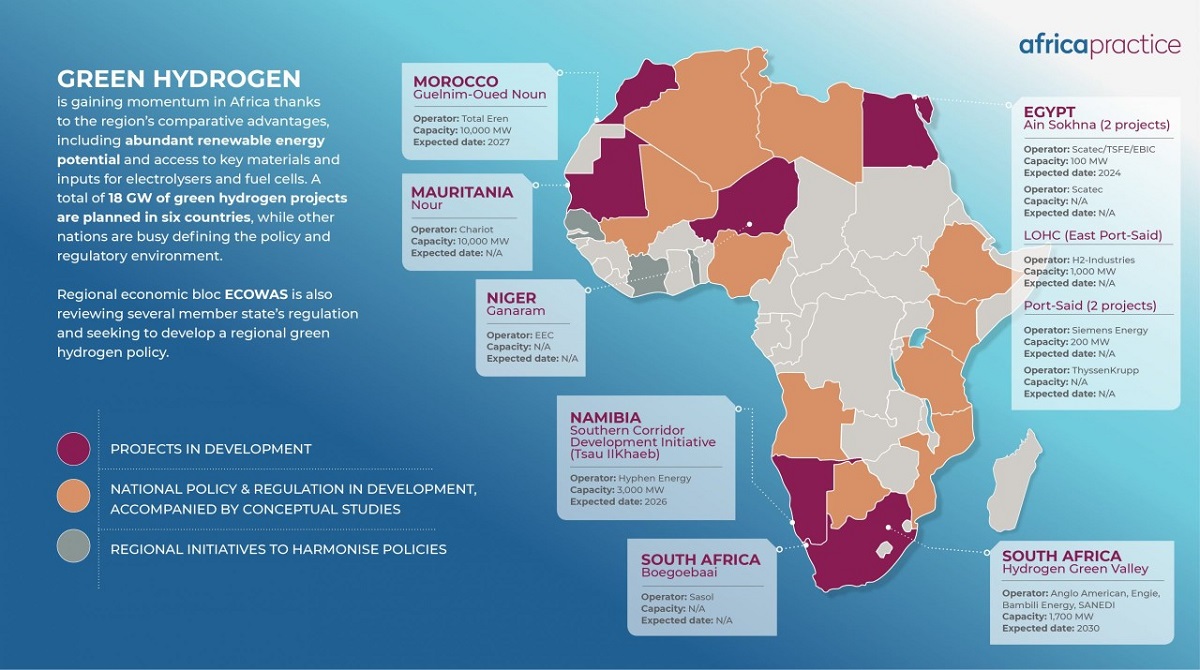- Globally, the hydrogen market exceeds $130 billion, and the World Bank is projecting an annual growth rate of over 9 per cent.
- The rising global demand for clean energy is opening doors for African nations to establish themselves as green hydrogen exporters.
- Across Africa, green hydrogen initiatives are taking root in Egypt, Niger, Morocco, South Africa, Namibia, and Mauritania.
Green hydrogen, derived from a clean process of electrolysation, can potentially transform the energy landscape in developing nations. Unlike traditional hydrogen production methods, which rely on fossil fuels, green hydrogen is produced using renewable energy sources like solar and wind power.
This innovation opens up new possibilities for decarbonisation and sustainable energy solutions. South Africa, Morocco, Mauritania, Namibia, Niger and Egypt are trailblazing the way for African economies, albeit with financing challenges. Recently, Kenya outlined its broad plan to tap into this industry, too.
Globally, the hydrogen market exceeds $130 billion, and the World Bank is projecting an annual growth rate of over 9 per cent. Like Africa, regions endowed with low-cost markets and abundant renewable resources are becoming preferred destinations for green hydrogen financing.
Africa’s Opportunity as a Green Hydrogen Exporter
The rising global demand for clean energy is opening doors for African nations to establish themselves as green hydrogen exporters. Increasingly, governments and stakeholders are appreciating the huge potential of green hydrogen in helping realise their set climate goals. Further, for policymakers, green hydrogen is becoming critical in driving the decarbonisation agenda across economies.
Moreover, introducing green hydrogen represents a substantial prospect for employment generation across the African continent. With Africa positioned as a potential global green hydrogen exporter, this sector holds the potential to become a huge contributor to the continent’s GDP. Additionally, the proceeds from green hydrogen exports could finance Africa’s infrastructure, education, and healthcare needs.
A report by advisory firm McKinsey on behalf of the Africa Green Hydrogen Alliance shows the continent’s GDP growth ranging from $66 billion to $126 billion by 2050 for member countries. Additionally, economies across Africa will register 4.2 million new jobs, attributable to investments in green hydrogen.
Approximately 80 per cent of the world’s hydrogen is generated using carbon-intensive processes primarily based on methane. Africa, however, holds the potential to produce an estimated 16,000 million tonnes of hydrogen annually.
The journey to global net-zero objectives
Doctoral Researcher Mulako Mukelabai, Dr Richard Blanchard from Loughborough University, and Professor Upul Wijayantha of Cranfield University have developed a blueprint for harnessing Africa’s renewable energy resources and mineral wealth to deliver clean energy to numerous households while contributing to global net-zero objectives.
Featured in the Renewable and Sustainable Energy Reviews Journal in 2022, the research by Mulako and the team zeroes in on hydrogen’s potential to drive decarbonisation in Africa. Whereas Africa contributes three per cent of global emissions, economies across the continent are paying the highest price globally.
The team examined the feasibility of tapping solar, wind, and biohydrogen (biologically produced hydrogen) to fuel electrolysis for the generation of green hydrogen.
Professor Wijayantha noted: “Africa not only has all the raw materials necessary to produce green hydrogen, but the continent also has excellent platforms for collaborations in the form of regional economic associations. If the right investment environment is created, Africa has the potential to thrive the hydrogen economy and significantly contribute to reducing the global emission levels.”
Kenya’s baby steps in tapping green hydrogen
Kenya has emerged as a leader in embracing green hydrogen technology within the East African community. The country’s investment in green hydrogen production reflects its dedication to a greener and more sustainable future. Kenya is strategically leveraging green hydrogen as a crucial component of its energy transition roadmap.
Kenya’s commitment to green hydrogen was solidified with its Green Hydrogen Strategy and Roadmap launch at the inaugural Africa Climate Summit in Nairobi. The strategy outlines the country’s vision for harnessing the potential of green hydrogen in its energy sector.
At the moment, Kenya’s energy landscape is dominated by renewable sources. Data shows that over 90 per cent of the country’s electricity is generated from hydropower, geothermal, solar, wind, and biomass. This positions Kenya as a prime candidate for adopting green hydrogen as an alternative energy source.
Kenya’s Ministry of Energy and Petroleum recognises the potential of green hydrogen to replace fossil fuels and stimulate the growth of a new economic sector. This transition not only reduces the country’s reliance on imported fuels but also retains more of the value-creation chain within Kenya. The result is the generation of domestic jobs and economic growth.
Key areas of interest in Kenya’s green hydrogen plant
The Kenya Green Hydrogen Organisation highlights four critical areas in developing Kenya’s Green Hydrogen strategy. One of the standout benefits is improved balance of payments.
According to the policy document, producing green hydrogen for industrial processes will reduce the need to import hydrogen-based products such as nitrogen fertiliser and methanol. Additionally, creating a domestic market for green hydrogen derivatives can boost exports, enhancing Kenya’s balance of payments.
Further, the ministry says investments in green hydrogen can address food security and bolster resilience. By embracing green hydrogen, Kenya will enhance local nitrogen fertiliser production, food security and resilience. This self-sufficiency improves agricultural productivity, encourages sustainable farming practices, and mitigates the impact of international commodity market fluctuations.
What’s more, the initiative will facilitate green industrialisation and decarbonisation plans. Green hydrogen can drive industrialisation by establishing manufacturing value chains for its derivatives. This fosters downstream industries, creates jobs, supports the growth of renewable energy, and improves access to electricity. It also aligns with global decarbonisation efforts and opens new markets for low-carbon products.
Attracting public and private investments
The green hydrogen industry has the potential to attract significant public and private investments, diversifying Kenya’s economy and fostering industrial growth. These investments span various sectors and applications, including power generation, hydrogen production, and related downstream facilities.
Kenya’s embrace of green hydrogen technology is a positive step towards achieving energy sustainability and a powerful driver of economic growth, job creation, and self-reliance. As the country continues to harness its abundant renewable energy sources and innovative mindset, green hydrogen will play a central role in Kenya’s journey towards a greener and more prosperous future.
On September 5, 2023, a partnership between the European Union and Kenya was unveiled at the UN Africa Climate Summit. The Green Hydrogen Strategy and Roadmap, which comes with a financial commitment of $13 million, was jointly announced by President William Ruto of Kenya and EU Commission President Ursula von der Leyen.
During their announcement, both leaders highlighted the strategy’s and roadmap’s extensive influence. In addition to its pivotal role in transitioning Kenya’s economy toward renewable energy sources, von der Leyen and Ruto noted that this partnership will enhance food security and bolster the agricultural industry.

Egypt, South Africa, Namibia, and Mauritania projects
Throughout Africa, green hydrogen initiatives are taking root in nations such as Egypt, South Africa, Namibia, and Mauritania. South Africa, the continent’s most advanced economy and the 14th largest global emitter of greenhouse gases, has made green hydrogen a central pillar of its journey towards decarbonisation. Estimates indicate the country needs about $17.28 billion to initiate its green hydrogen plans. Reuters says South Africa is liaising with Germany on key green hydrogen investments.
In March, the Germany-based company Conjuncta signed an agreement with Mauritania, Egypt’s power company Infinity, and the UAE’s Masdar for a $34 billion green hydrogen investment in the West African nation. Upon completion, the Mauritania project is slated to yield 8 million tonnes of green hydrogen annually. Conjuncta states that the investment’s electrolyser in Mauritania boasts a capacity of up to 10GW.
European nations are increasingly turning to Africa to secure future supplies of this fuel, making huge investments in green hydrogen ventures.
Green hydrogen notes from Chile—a mining giant
While Kenya’s plan is mainly on paper awaiting implementation, African nations can learn from the Chilean experience. Chile, a nation with approximately 20 million population, is a heavyweight in the global mining industry. Notably, 22 per cent of the world’s copper reserves are within this South American nation. The World Bank acknowledges that Chile recognises the potential of green hydrogen in decarbonising its vast mining sector.
Since 2020, the global lender has supported Chile’s efforts to establish regulatory frameworks conducive to fostering the demand for green hydrogen in domestic and international markets. In June this year, the World Bank okayed a $150 million loan to bolster investments in green hydrogen within Chile.
This strategic move is poised to accelerate Chile’s strides in green growth, energy transition, and its commitment to being carbon neutral by 2050.
The “Chile Green Hydrogen Facility to Support A Green, Resilient and Inclusive Economic Development” project is set to deliver huge benefits to local communities. This initiative is geared towards the local production and use of clean hydrogen, fostering the creation of environmentally friendly jobs, stimulating economic growth, and facilitating the decarbonisation of Chilean industries.
Private sector financing
“Chile has exceptional attributes for developing a competitive green hydrogen industry given its renewable resources and ability to attract investment in large-scale clean energy projects,” said Carlos Felipe Jaramillo, World Bank Vice President for Latin America and the Caribbean.
The World Bank added that the financing will help attract additional resources, approximately $280 million, from the private sector. Chile harbours aspirations to become the global leader in low-cost hydrogen production by 2030. The country expects to become one of the top three hydrogen exporters by 2040.
Chile’s projected green hydrogen exports
Chile’s National Green Hydrogen Strategy estimates suggest that this burgeoning industry may yield up to $330 billion in private investment opportunities. Moreover, the green hydrogen industry can account for about $30 billion in exports by 2050.
In a broader context, green hydrogen stands out as a crucial tool in decarbonising sectors. This is especially true in areas where electrification is technically challenging or economically impractical.
Industries such as manufacturing and heavy or long-distance transport can also greatly benefit from green hydrogen. Moreover, extended storage periods make green hydrogen an enhanced energy security. This will facilitate the seamless integration of renewable energies into the grid.
Furthermore, the development of this industry has the potential to bolster food security by utilising green hydrogen in the production of green ammonia, a vital component of fertilisers.











